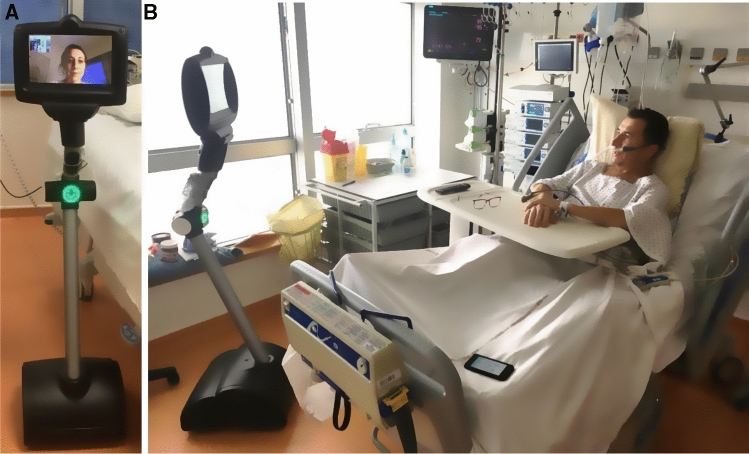The COVID-19 pandemic has caused a variety of situations that have resulted in limited hospital visits of family members. Psychological distress has clearly increased for patients, family members, and intensive care unit (ICU) staff because of visiting restrictions.1–4 Family members of isolated COVID-19 patients in the ICU experience moral injury with prevalence of anxiety and depression of 83% and 73%, respectively.2 Thus, intensivists are faced with an impossible equation: (i) they should promote interactions between the relatives and the critically ill patients to prevent post-traumatic stress disorder; however, (ii) they need to ensure patient, staff, and visitor safety—and thus respect the restrictions of hospital visits.1
Here, we show a remote-controlled robot that helps to support communication between patients and their relatives. The robot is fully equipped with communication technology and is controlled by the family who becomes present from a distant location and can virtually explore the room (Figure). Conscious patients can communicate with the avatar of the family with a certain degree of independence and privacy (Figure). The family can be virtually present at the bedside and receive daily information during nursing care or participate in family conferences with ICU clinicians. Family members of unconscious patients can be introduced to the ICU environment and have a better understanding of the situation.
Figure.
A telepresence robot (UBBO telepresence robot, AXYN, France) is controlled by the family from a remote location and provides a virtual presence of the family within the isolation room of the COVID-19 patient. A) The robot is a wheeled device, controlled from a remote location that can move in the room or adjust its head rotation to optimize face-to-face meetings. It includes a tablet with 4G connectivity, video camera, screen, speakers, and microphones. A dedicated website is used to secure the connection and to avoid using personal login or phone numbers; no information is stored. It can be shared between patient rooms after an approved process of disinfection. B) The telepresence robot enhances communication between the relatives and the patient. The patient reported that the regular presence of unmasked familiar faces brought immediate relief.
By providing a virtual presence of patients’ families, psychological distress may be reduced in in critically ill patients (able to see their loved-one despite the life-threatening situation) and family members (feeling less guilty for not being more present, being able to observe their loved one, and being reassured about their comfort). A telepresence robot in isolation rooms may limit the psychological burden of limited visits.
Acknowledgement
We thank the patients, families, and caregivers.
Author contribution
The patient provided written permission to publish this report.
Disclosures
None.
Funding statement
The telepresence robot equipment was funded by “Fond de dotation du CHU de Tours”.
Editorial responsibility
This submission was handled by Dr. Sangeeta Mehta, Associate Editor, Canadian Journal of Anesthesia/Journal canadien d’anesthésie.
Footnotes
Publisher's Note
Springer Nature remains neutral with regard to jurisdictional claims in published maps and institutional affiliations.
References
- 1.Azoulay É, Curtis JR, Kentish-Barnes N. Ten reasons for focusing on the care we provide for family members of critically ill patients with COVID-19. Intensive Care Med. 2021;47:230–233. doi: 10.1007/s00134-020-06319-5. [DOI] [PMC free article] [PubMed] [Google Scholar]
- 2.Cattelan J, Castellano S, Merdji H, et al. Psychological effects of remote-only communication among reference persons of ICU patients during COVID-19 pandemic. J Intensive Care. 2021 doi: 10.1186/s40560-020-00520-w. [DOI] [PMC free article] [PubMed] [Google Scholar]
- 3.Sasangohar F, Dhala A, Zheng F, Ahmadi N, Kash B, Masud F. Use of telecritical care for family visitation to ICU during the COVID-19 pandemic: an interview study and sentiment analysis. BMJ Qual Saf. 2020 doi: 10.1136/bmjqs-2020-011604. [DOI] [PMC free article] [PubMed] [Google Scholar]
- 4.Suresh D, Flatley K, McDonough M, et al. Providing compassionate care: the role of medical students and videoconference technology in the COVID-19 pandemic. J Patient Exp. 2020;7:1002–1006. doi: 10.1177/2374373520978873. [DOI] [PMC free article] [PubMed] [Google Scholar]



